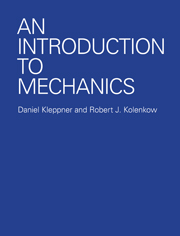Book contents
- Frontmatter
- Contents
- LIST OF EXAMPLES
- PREFACE
- TO THE TEACHER
- AN INTRODUCTION TO MECHANICS
- 1 VECTORS AND VECTORS KINEMATICS—A FEW MATHEMATICAL PRELIMINARIES
- 2 NEWTON'S LAWS—THE FOUNDATIONS OF NEWTONIAN MECHANICS
- 3 MOMENTUM
- 4 WORK AND ENERGY
- 5 SOME MATHEMATICAL ASPECTS OF FORCE AND ENERGY
- 6 ANGULAR MOMENTUM AND FIXED AXIS ROTATION
- 7 RIGID BODY MOTION AND THE CONSERVATION OF ANGULAR MOMENTUM
- 8 NONINERTIAL SYSTEMS AND FICTITIOUS FORCES
- 9 CENTRAL FORCE MOTION
- 10 THE HARMONIC OSCILLATOR
- 11 THE SPECIAL THEORY OF RELATIVITY
- 12 RELATIVISTIC KINEMATICS
- 13 RELATIVISTIC MOMENTUM AND ENERGY
- 14 FOUR VECTORS AND RELATIVISTIC INVARIANCE
- INDEX
1 - VECTORS AND VECTORS KINEMATICS—A FEW MATHEMATICAL PRELIMINARIES
- Frontmatter
- Contents
- LIST OF EXAMPLES
- PREFACE
- TO THE TEACHER
- AN INTRODUCTION TO MECHANICS
- 1 VECTORS AND VECTORS KINEMATICS—A FEW MATHEMATICAL PRELIMINARIES
- 2 NEWTON'S LAWS—THE FOUNDATIONS OF NEWTONIAN MECHANICS
- 3 MOMENTUM
- 4 WORK AND ENERGY
- 5 SOME MATHEMATICAL ASPECTS OF FORCE AND ENERGY
- 6 ANGULAR MOMENTUM AND FIXED AXIS ROTATION
- 7 RIGID BODY MOTION AND THE CONSERVATION OF ANGULAR MOMENTUM
- 8 NONINERTIAL SYSTEMS AND FICTITIOUS FORCES
- 9 CENTRAL FORCE MOTION
- 10 THE HARMONIC OSCILLATOR
- 11 THE SPECIAL THEORY OF RELATIVITY
- 12 RELATIVISTIC KINEMATICS
- 13 RELATIVISTIC MOMENTUM AND ENERGY
- 14 FOUR VECTORS AND RELATIVISTIC INVARIANCE
- INDEX
Summary
Introduction
The goal of this book is to help you acquire a deep understanding of the principles of mechanics. The subject of mechanics is at the very heart of physics; its concepts are essential for understanding the everyday physical world as well as phenomena on the atomic and cosmic scales. The concepts of mechanics, such as momentum, angular momentum, and energy, play a vital role in practically every area of physics.
We shall use mathematics frequently in our discussion of physical principles, since mathematics lets us express complicated ideas quickly and transparently, and it often points the way to new insights. Furthermore, the interplay of theory and experiment in physics is based on quantitative prediction and measurement. For these reasons, we shall devote this chapter to developing some necessary mathematical tools and postpone our discussion of the principles of mechanics Until Chap. 2.
Vectors
The study of vectors provides a good introduction to the role of mathematics in physics. By using vector notation, physical laws can often be written in compact and simple form. (As a matter of fact, modern vector notation was invented by a physicist, Willard Gibbs of Yale University, primarily to simplify the appearance of equations.)
- Type
- Chapter
- Information
- An Introduction to Mechanics , pp. 1 - 50Publisher: Cambridge University PressPrint publication year: 2010



